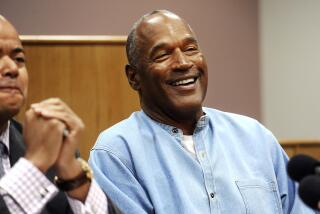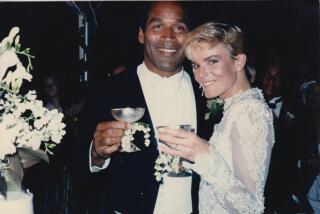THE O.J. SIMPSON MURDER TRIAL : Dealing With the Race Issue Gets No Easier
- Share via
Reporters will again be forced to deal with the O.J. Simpson murder trial’s complex racial aspects now that the defense has begun presenting its case.
Race, of course, has been an undertone from the beginning. But it has been ignored in the past few weeks as prosecutors presented their forensic evidence--hair, fiber, blood and DNA.
Now the Simpson team will concentrate on a theme that resonates with race--that the Los Angeles Police Department, long accused of hostility toward African Americans, conspired to frame the black sports hero.
*
The journalists’ difficulty in covering this legal strategy is that the word race probably won’t be invoked by the defense team, except when Simpson’s lawyers attack Detective Mark Fuhrman, whom they have portrayed as a racist.
Rather, the Simpson team is more likely to bring up race in a more subtle, between-the-lines fashion. The defense lawyers will use anecdotes that play on the collective memories of the African Americans who compose a majority of the jury.
The African American jurors are part of a black L.A. community that has many memories of unpleasant and even dangerous daily contacts with the LAPD. In uncounted family histories are found stories of a son, a father, an uncle, a cousin ordered out of a car for no reason and confronted with drawn guns. Or of cops storming through houses and apartments on mistaken drug raids.
Chief defense attorney Johnnie L. Cochran Jr. indirectly recalled the rough-cop image Monday when he questioned Arnelle Simpson, O.J.’s daughter. Prompted by Cochran’s sympathetic questions, the young woman told a powerful story of a devastated, distraught and closely knit Simpson family receiving the horrifying news of Nicole Simpson’s murder. Any family could identify with their reaction.
But interspersed in her testimony was another story that evoked images that may have had a special relevance to the African American jurors. This was the story of white Los Angeles police detectives, including Fuhrman, prowling the grounds of the Simpson mansion, giving the distraught Arnelle a minimum of information, forcing her to leave the house while she was caring for little Justin and Sydney Simpson, her brother and sister.
“Had you leave your own house?” asked Cochran, driving home the point. “Yes,” she replied.
The courtroom scene brought to mind a discussion I heard a couple of weeks ago when a panel of African American, Latino and Asian American journalists talked about the Simpson case and race.
They were members of the Unity Media Access Project, which aims to improve news coverage of racial issues and minority communities. It was formed after the 1992 riots to teach minority community groups how to get their stories in the newspapers and on television and radio.
But even this panel, attuned to L.A.’s racial coverage, had no answers.
In the old days of L.A. newspapering, said KNX radio reporter Luis Torres, racial insults made their way into print every day. Newspaper writers, he said, routinely referred to Latinos as “wetbacks” and Japanese Americans as “Japs.”
By the time Torres studied journalism, things had changed. “They told us not to mention race unless it was relevant,” he said. But what about the Simpson trial, where race is, and is not, an issue? “How, without being sensational, do we really deal with this sensitive question?” Torres asked.
This is something I wrestle with both in writing about the Simpson trial and in my part-time job teaching journalism at USC. At school, I’m supposed to advise students about when it is right to refer to a person’s race. At work, I have to decide when to identify O.J. Simpson as an African American and to deal with the issues raised by his race.
At USC, one of our teaching guides is the Associated Press Stylebook, which says that reporters should identify people by race “when it provides the reader with substantial insight into conflicting emotions known or likely to be involved in a demonstration or some similar event.”
At The Times, our Guidelines on Ethnic and Racial Identification advise editors and reporters that “when deciding whether to mention someone’s race, ask yourself: Is the ethnic or racial identification needed? Is it important to the context of the story? Is the story complete without reference to race or ethnic identification?”
*
All this advice was of no use to me Monday as I watched Arnelle Simpson on the witness stand.
Her testimony wasn’t about race relations--but it was. There’s nothing in our guidelines to deal with this situation. We reporters are thrown back on common sense and sensitivity.
More to Read
Sign up for Essential California
The most important California stories and recommendations in your inbox every morning.
You may occasionally receive promotional content from the Los Angeles Times.













